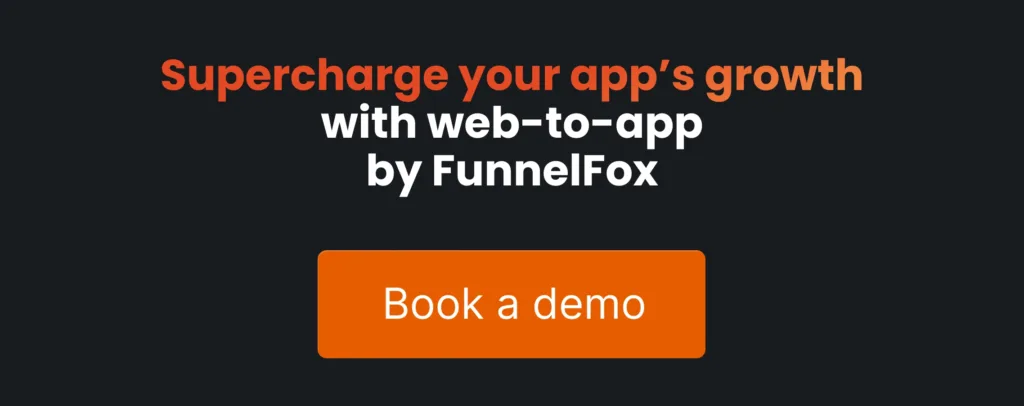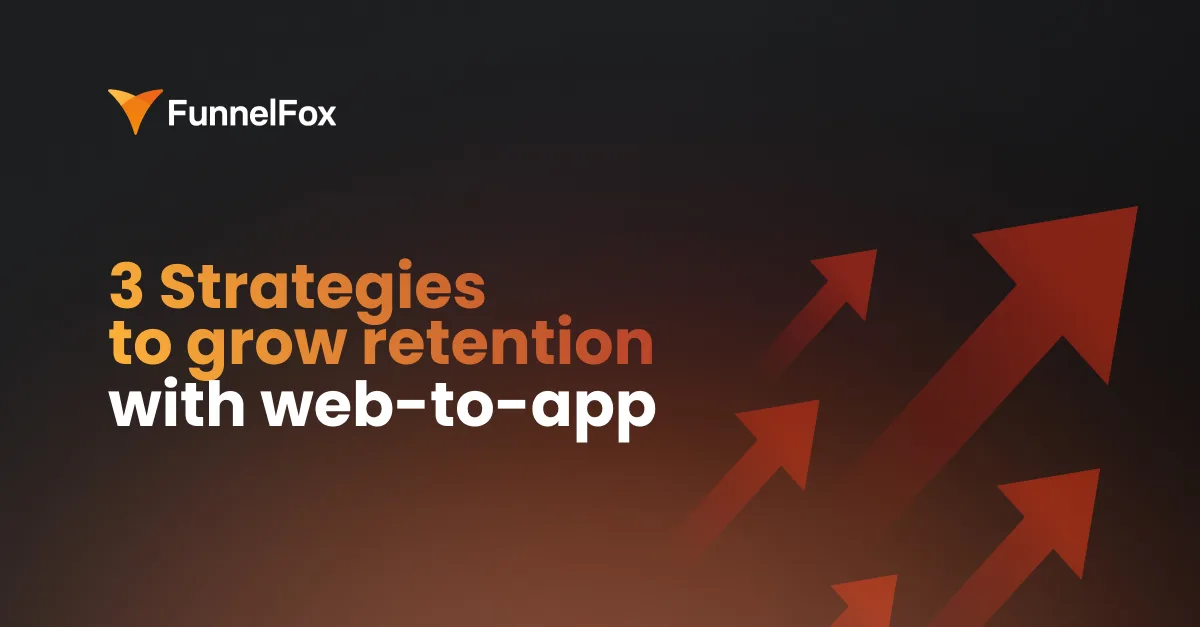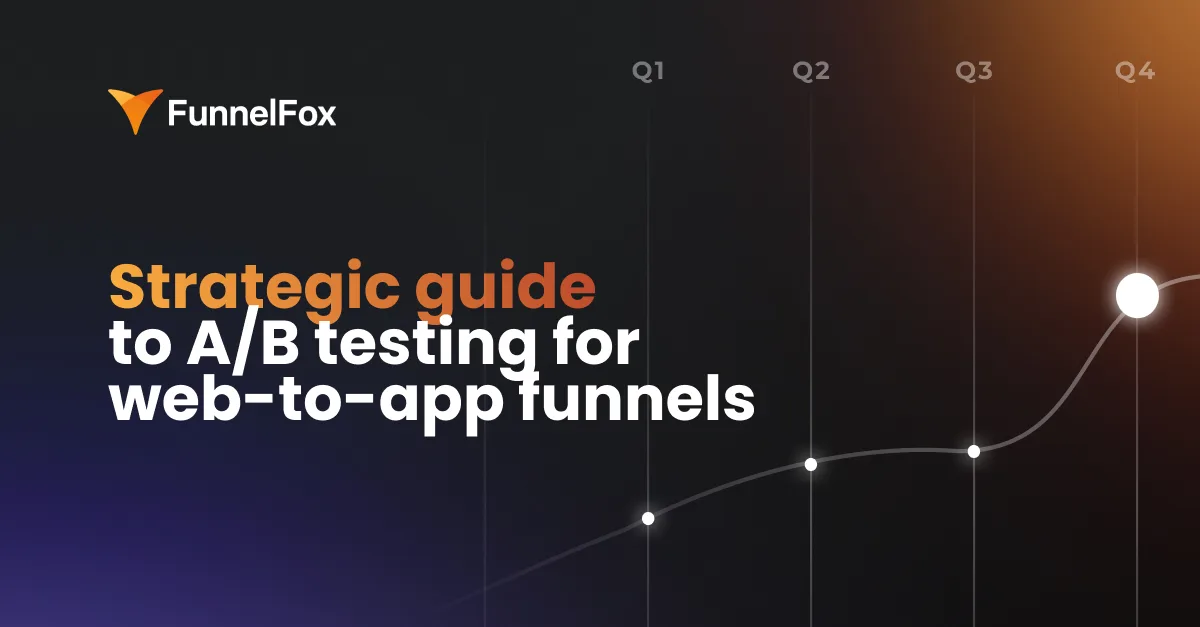Scaling a consumer subscription app is a challenge that many founders face. While launching an app is relatively easy, achieving sustainable growth is a whole different story. At our recent webinar, Phil Carter, CEO of Elemental Growth & growth advisor for consumer subscription startups, and Andrey Shakhtin, CEO of FunnelFox, discussed The Subscription Value Loop—a framework that helps subscription businesses spot their biggest growth opportunities.
This article covers the key insights from the webinar, breaking down the strategies and frameworks that help subscription apps scale efficiently. If you’re not into reading much, you can watch the recording.
Consumer subscription apps are easy to launch but hard to scale
The subscription app boom over the past decade is hard to ignore. Since Apple and Google introduced in-app subscriptions, more than 100,000 subscription apps have popped up across categories like health & fitness, education, productivity, media, and entertainment.
However, only a small fraction of these apps have achieved massive success. According to AppFigures, fewer than 50 have ever hit a $1 billion valuation. Right now, only about 30 apps are at that level, and fewer than 10 have crossed the $10 billion mark and gone public.
Most of these big wins come from just four categories:
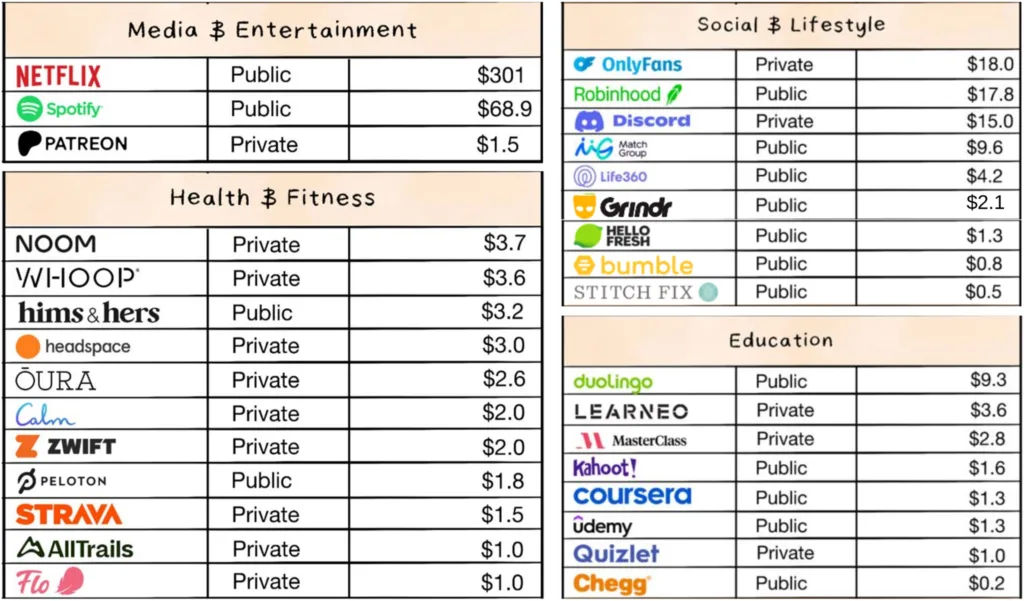
But even the biggest apps don’t have it easy. Duolingo, Bumble, and Spotify have all had their fair share of ups and downs, proving how tough it is to keep a consumer subscription business growing over time.
So with so many subscription apps out there, why do only a few break through? Because launch is easy, but scaling is a whole different game—and it comes down to three big challenges.
1. Hard to acquire users
Most subscription apps rely on paid ads, mainly through Meta and Google. But ever since Apple’s ATT update and SKAN, ads have gotten more expensive and less predictable. That’s why more apps are turning to web2app flows—they help work around ATT, optimize ad spend, and improve ad ROI.
2. Hard to retain users
Unlike B2B SaaS, where customers stick around for years, consumer subscriptions are hard to keep. Users come and go fast, especially when they don’t see continuous value.
Even top-quartile subscription apps (the top 25%) struggle with retention:
- less than 6% of installs convert to paid subscriptions
- over 50% of annual subscribers churn after one year
- over 50% of monthly subscribers churn within just three months
However, the top 5% of apps tell a different story:
- 15%+ of installs convert to paid subscriptions
- 60%+ of subscribers retained after 3 months (monthly plans) or 1 year (annual plans)
3. Hard to monetize users
Consumer apps typically have a single-user monetization model with no expansion revenue. Unlike B2B SaaS, where companies can upsell and increase revenue per customer, consumer apps usually rely on one primary subscription tier. This makes it harder to offset churn from lower-value subscribers by capturing more value from high-intent users.
The big question: how do you make it into the top 5% of apps that successfully scale? This is where the Subscription Value Loop comes in.
The Subscription Value Loop: what it is & how it works
The Subscription Value Loop is a three-step framework that helps consumer subscription businesses find and maximize their biggest growth opportunities. At its core, this framework revolves around a unique and enduring value proposition, supported by three key steps:
- Value creation – Building a product people love and want to keep using
- Value delivery – Effectively acquiring and onboarding new users
- Value capture – Converting free users into paying subscribers and maximizing retention
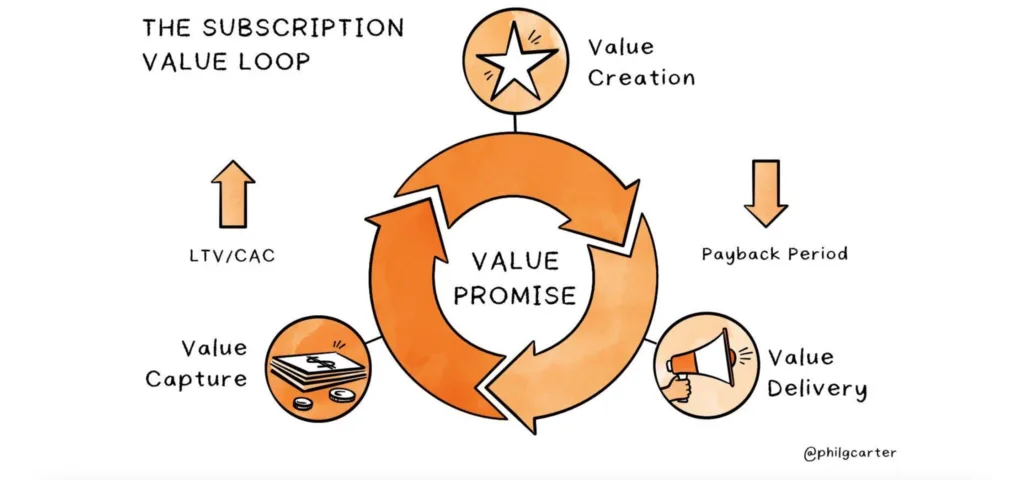
The better you optimize each step in the Subscription Value Loop, the higher your LTV-to-CAC ratio, the faster you recover acquisition costs, and the more capital you can reinvest to scale. Let’s take a closer look at each step.
1. Value creation: build a great product that offers ongoing value to subscribers
Every successful subscription app is built on a strong core value proposition—something that sets it apart and keeps users engaged over time. To drive long-term growth, this value must be both unique (different from competitors) and lasting (continuously delivering value over time).
Some of the best-known examples of strong value propositions:
- Spotify – Unlimited music and personalized playlists
- Duolingo – Fun and gamified language learning with proven effectiveness
- Strava – Social network for athletes, tracking performance and progress
- Tinder – Smarter matchmaking based on user preferences and engagement
These companies have embedded their core value so deeply into their products that most users could recognize them without the logo by their value proposition alone.
Winning at value creation: Duolingo
Duolingo has built an extremely effective value creation strategy through:
- Immersive onboarding. Instead of telling users why it’s better than competitors, Duolingo shows them through an interactive experience.
- Gamification. Streaks, badges, leaderboards, and challenges make learning addictive.
- AI-driven personalization. Its “Burn Brain” algorithm dynamically adjusts difficulty to optimize learning.
- Proven efficacy. While Duolingo isn’t yet on par with college-level language courses, it’s getting close—at a much lower price point (~$80/year).
By making learning fun and continuously reinforcing value, Duolingo keeps subscribers engaged and minimizes churn.
2. Value delivery: acquire users cost-efficiently
Creating a great product is just the first step—you also need to get it into the hands of the right users. This step, typically led by marketing and growth teams, involves strategies like:
- Paid advertising – Meta, Google, TikTok, Apple Search Ads, etc.
- SEO & ASO – organic discovery through search engines and app stores
- Virality & word of mouth – social sharing, referrals, and influencer collaborations
- Web2app flows – optimizing onboarding and conversion funnels for better tracking and efficiency
Winning at value delivery: Strava
Strava has grown massively without over-relying on paid ads thanks to:
- Community-driven marketing – there’s the whole mantra: “If it didn’t happen on Strava, it didn’t happen”
- Social sharing features – users can post workouts on other platforms
- Influencer partnerships & event marketing – collaborations with top athletes and fitness enthusiasts, offline events like Camp Strava
- Improving paid ads efficiency – e.g., targeting high-intent users through web2app funnels
Don’t know where to start with web2app? Download our step-by-step guide on launching efficient web2app funnels.
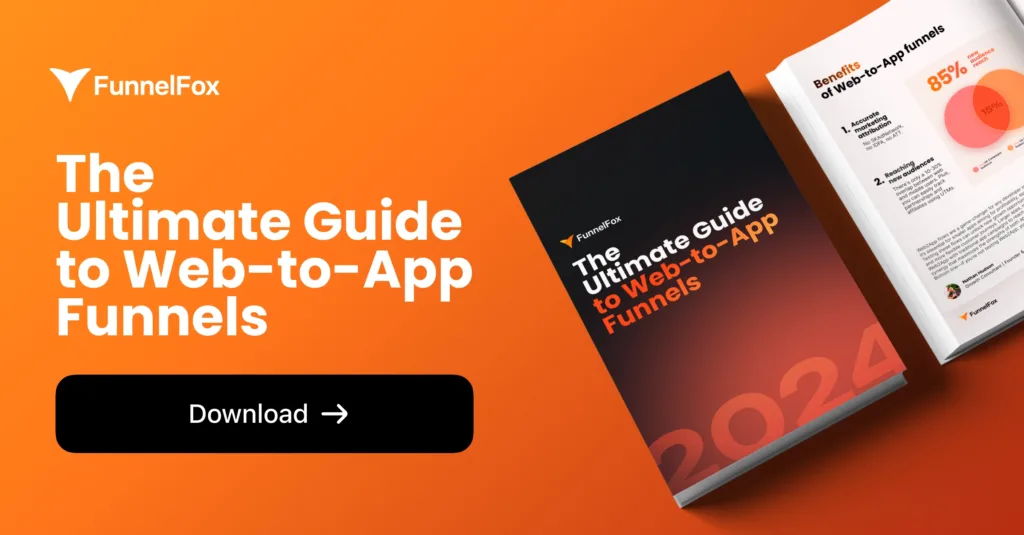
3. Value capture: convert free users into subscribers and generate revenue to reinvest in the business
Acquiring millions of users doesn’t mean much if you can’t turn them into paying subscribers. Strong monetization is what makes a subscription business sustainable—capturing value from users while improving retention and LTV.
Winning at value capture: Tinder
Dating apps have a built-in challenge—if they work, users leave. Hence, they need to monetize quickly and effectively. Tinder has mastered this by:
- Offering multiple subscription tiers – Tinder Plus, Gold, and Platinum, each offering different levels of premium features
- Selling one-time in-app purchases – additional features beyond the core subscription (e.g., Boosts and Super Likes)
- Using contextual upsells – premium features are offered at the right time based on user behavior
- Constantly testing pricing – optimizing price points to improve conversion rates
This approach has helped Tinder to generate over $1 billion in annual revenue, despite its natural churn challenges.
What happens when one of the steps fails?
Not every subscription app gets it right. Let’s look at three companies that ran into trouble in different steps of The Subscription Value Loop.
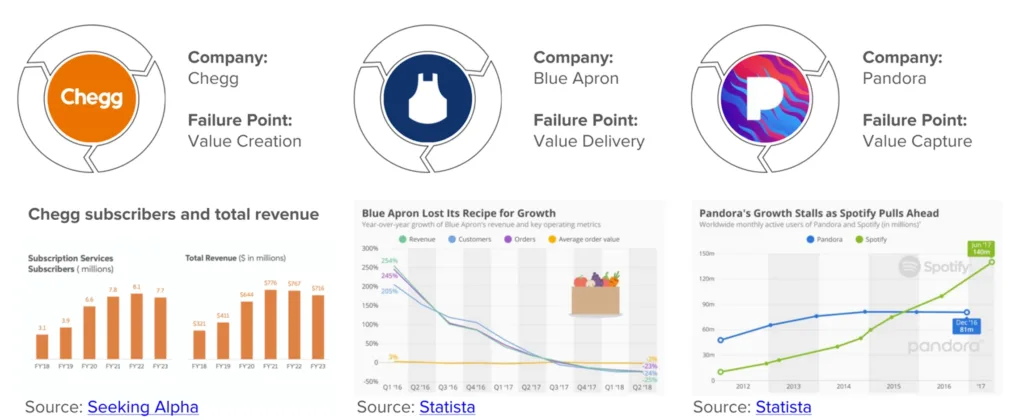
When value creation fails: Chegg
Chegg, a homework help app, once had a strong value proposition for students. But as AI-powered tools like ChatGPT and Claude emerged, its core value eroded. Students found free alternatives, subscriber growth tanked, and Chegg’s valuation crashed—from over $10B to under $1B.
When value delivery fails: Blue Apron
Blue Apron relied too heavily on paid ads for user acquisition. As its CAC increased and LTV declined, the company hit a point where its unit economics no longer worked, leading to stalled growth.
When value capture fails: Pandora
Pandora was an early leader in music streaming, but it stuck to an ad-supported model rather than subscriptions and generated very little revenue per user. Meanwhile, Spotify built its business on subscriptions, driving much higher revenue per user and eventually outpacing Pandora’s market share.
How to quantify your Subscription Value Loop & identify growth opportunities
To help you understand how your app performs within the Value Loop, Phil Carter introduced the Subscription Value Loop Calculator—a free benchmarking tool that helps consumer subscription businesses measure their performance, spot weaknesses, and identify high-impact growth opportunities.
The first version of the Calculator is focused on direct-to-app metrics. As web2app flows become more important, future updates will include web2app-specific benchmarks to help companies measure the impact of web-based onboarding strategies on key growth metrics.
You can access the calculator here, but first, let’s find out how to use it to get actionable insights.
How to use the Subscription Value Loop Calculator
The Subscription Value Loop Calculator lets you compare your app’s performance against industry benchmarks to fine-tune value creation, delivery, and capture. Here’s how to use it:
- Set your benchmarks. Select your app category, growth tier (25th, 50th, 75th, or 95th percentile), and geography.
- Input your metrics. Enter your app’s performance data from the past 12 months to account for seasonality. If you’ve made major changes (like pricing updates or a new trial model), use more recent data that reflects those updates.
- Compare against benchmarks. The calculator pulls category-specific benchmarks, showing how your app measures up across 22 key metrics, including LTV-to-CAC ratio, retention rates, acquisition costs, and subscription pricing.
- Spot growth opportunities. A heatmap highlights areas where you’re overperforming (green) and underperforming (red), helping you identify bottlenecks in value creation, delivery, or capture.
- Prioritize high-impact improvements – Focus on the biggest gaps and optimize the metrics that will drive higher LTV-to-CAC ratios and a faster payback period.
How to analyze your results?
The calculator compares your app’s data against industry benchmarks, highlighting:
- Green – Where you’re outperforming the benchmark.
- Red – Areas where you’re falling behind, signaling growth opportunities.
Take a hypothetical North American health & fitness app:
- LTV-to-CAC ratio: 2.7x (not bad, but below the 3.3x benchmark)
- Payback period: Slightly longer than ideal
- Sign-up & activation rates: Low, suggesting onboarding inefficiencies
- Subscription pricing: Below market standards, limiting revenue potential
This analysis makes it easy to spot weak points that hurt your growth.
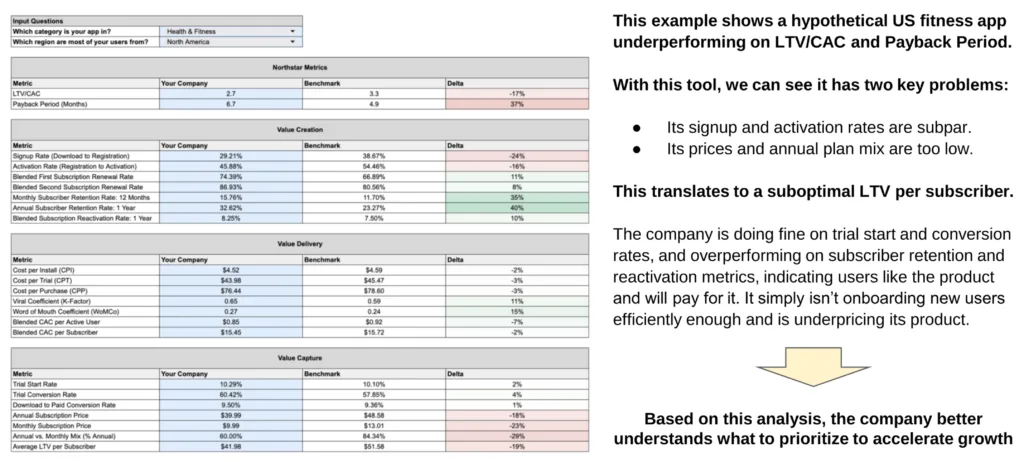
Six proven web2app tactics to improve the performance of your Subscription Value Loop
Web2app flows have gained massive traction recently, particularly after Apple introduced ATT and SKAN. Why? Because web2app offers three big advantages over traditional app store onboarding:
- Better marketing attribution. Web-based flows capture deterministic data, which can be fed back into ad networks to improve targeting and campaign performance.
- Lower costs & higher LTV. Web checkouts bypass 15-30% app store fees and often lead to better subscriber retention by reducing payment failures.
- Faster experimentation. A/B testing on the web is quicker and easier, so teams can refine onboarding flows without waiting for app store approvals.
Let’s explore six web2app tactics that can make a real impact on your Subscription Value Loop.
Tactic #1: Deliver immediate value within the first minute
Tied to: Value Creation
Key metrics: Sign-up rate, activation rate, trial start rate, trial conversion rate
First impressions matter. The faster users experience value, the more likely they are to convert. Web2app onboarding should highlight the core value upfront, remove unnecessary friction, and create an emotional connection with the product.
Let’s take Duolingo as an example. From the very first minute, users experience real value through personalized onboarding, gamification, and web-based interactivity. This makes learning engaging, builds habits, and drives conversion even before they install the app.
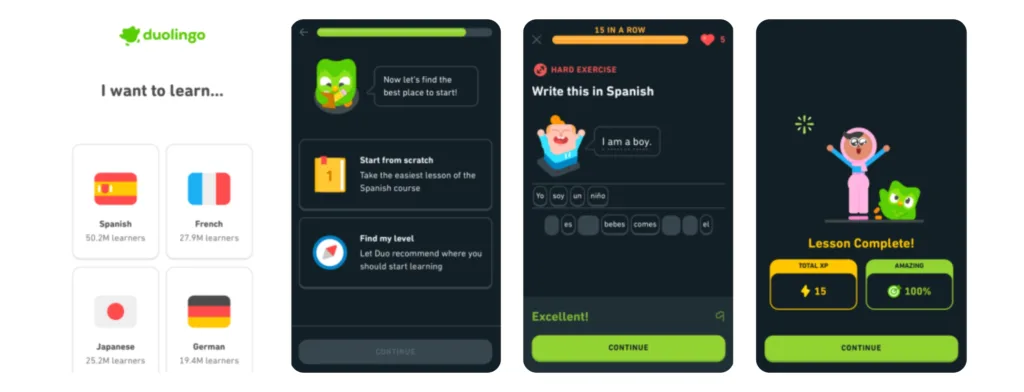
Noom applies the same principle with its onboarding quiz, which tailors a weight loss plan and creates an emotional aha moment before leading users into a premium plan offer.
Tactic #2: Use onboarding quiz questions to predict each user’s LTV and optimize ad campaigns
Tied to: Value Creation & Value Delivery
Key metrics: CPI, cost per trial, paid CAC per subscriber, LTV
One of the most effective web2app tactics is using onboarding quizzes to personalize the user experience and optimize marketing performance. These quizzes serve a dual purpose:
- Personalized experience → higher engagement & retention
- Data collection → smarter ad targeting & LTV optimization
A great example of this tactic efficiency is Noom. Its onboarding process is infamously long—it can include 50 to 100+ questions and take up to 30 minutes to complete. While this may seem excessive, it actually works in Noom’s favor. Here’s why:
- Users feel heard – Instead of a generic sign-up, Noom creates a tailored, highly personalized plan based on users’ unique goals, struggles, and habits.
- Stronger emotional investment – By the end of the quiz, users are more likely to feel committed to Noom’s approach.
- Optimized for higher LTV – The quiz not only personalizes the weight loss program but also segments users by willingness to pay, ensuring higher-quality leads.
Web2app quizzes allow deterministic data collection—a massive advantage over ATT-restricted mobile-only flows. Noom feeds this data back into ad platforms, identifying high-value users and refining audience targeting.
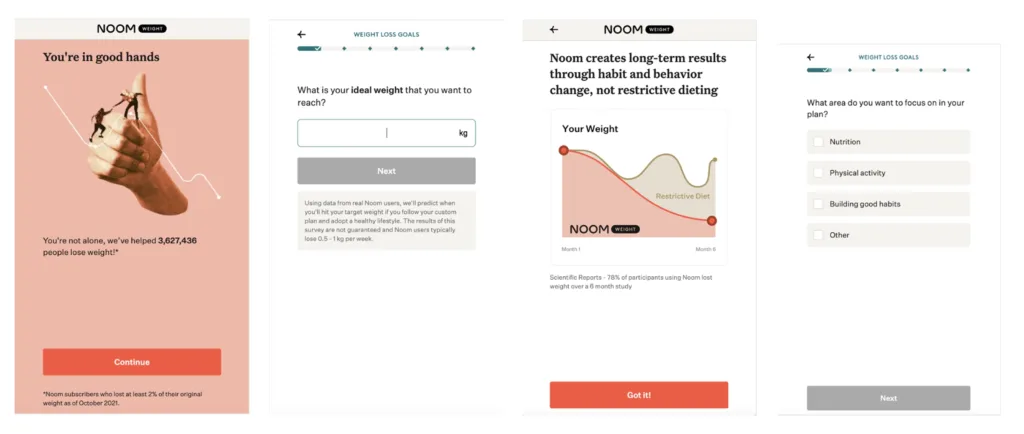
Ladder, a fast-growing strength training app, has successfully applied a similar approach. Their web-based quiz segments users by fitness level and goals, ensuring they are matched with the most relevant workout plan. This not only improves engagement but also helps Ladder refine its ad targeting, reducing CAC and maximizing LTV. Since adopting this strategy in 2023, the company has seen a 2000% growth.
Tactic #3: Maximize premium subscription paywall visibility and conversion rates
Tied to: Value Capture
Key metrics: Trial start rate, trial conversion rate, install-to-paid conversion, subscription plan mix
One of the most overlooked yet important metrics for subscription businesses is the paywall view rate—the percentage of users who see a paywall during their first session. Research shows a correlation between paywall visibility, trial start rates, and overall revenue conversion. If users aren’t aware of your premium offering, they won’t subscribe.
Subscription apps should aim for a paywall view rate of 80%+. The right timing is the key here. A paywall that appears too soon can feel intrusive, while one that appears too late may lead to missed conversion opportunities. The sweet spot is right after they’ve experienced value but before engagement declines.
Calm, the popular meditation app, gets this balance right. Their onboarding is short and focused, guiding users through a few quick questions before introducing the paywall. Instead of overwhelming users, Calm highlights its core benefits and smoothly transitions into a free 14-day trial offer. Here’s how Calm optimizes its paywall strategy:
- Prioritizing annual plans – Encouraging longer commitments for better retention and LTV.
- Offering multiple payment options – Apple Pay, PayPal, and other methods to reduce friction.
- Timing the paywall strategically – Ensuring users see it at a high-conversion moment.
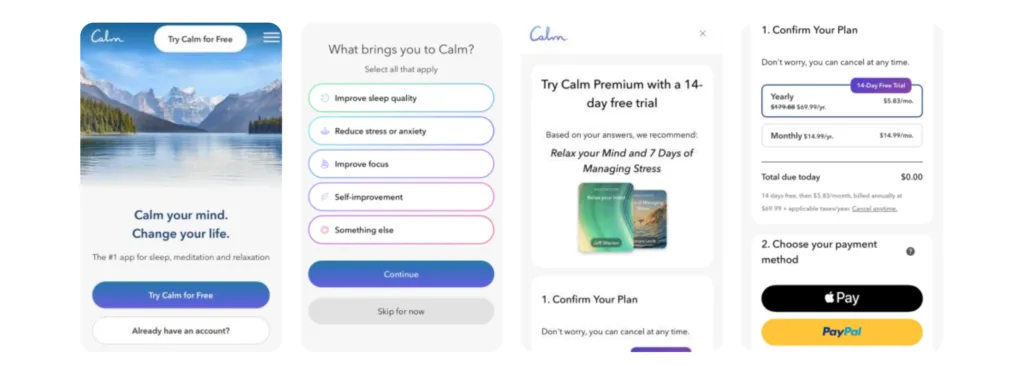
Tactic #4: Leverage strategic discounts and promotions to boost subscriber conversion
Tied to: Value Capture
Key metrics: Trial start rate, trial conversion rate, install-to-paid conversion rate
Discounts work wonders when you need to convert users who hesitate at full price—but they need to be used wisely. The goal is to capture lower-intent users without cannibalizing revenue or training users to expect constant discounts.
Here are four effective discounting strategies for web2app funnels:
- Activity-based discounts. Since 75–80% of trial starts happen within the first session or 48 hours, offering a limited-time discount (e.g., 10–30%) to users who don’t convert right away can provide the final push.
- Location-based discounts. Willingness to pay varies across markets, so adjusting pricing based on country or region ensures affordability while maximizing revenue potential in different locations.
- Demographic-based discounts. While certain targeting (e.g., by gender or race) is legally restricted, discounts for students, educators, military personnel, or seniors can make premium plans more accessible to users with lower disposable income.
- Seasonal promotions. Timing discounts around high-intent periods (e.g., New Year’s for fitness apps, back-to-school for education apps) taps into natural spikes in demand.
Headway, a personal growth app, executes this strategy by showing a personalized onboarding flow followed by a standard paywall. If a user hesitates, they are presented with a 51% welcome discount—a well-timed offer that significantly boosts conversions.
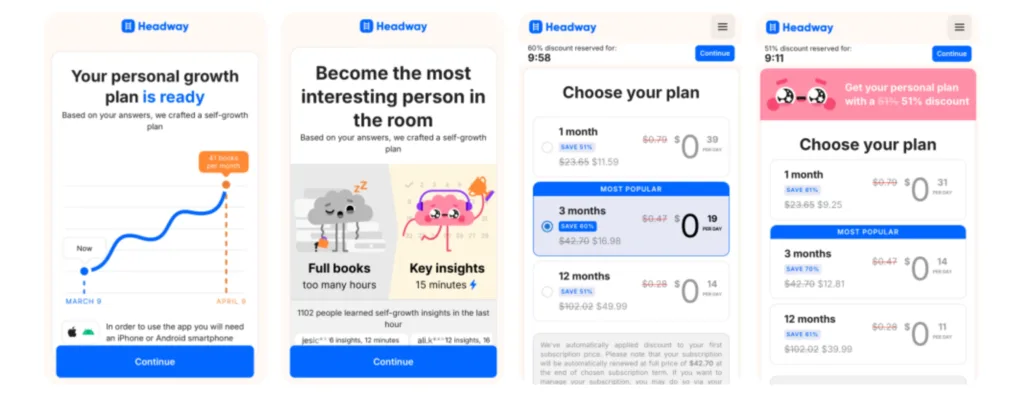
While some risk exists (e.g., users learning to delay purchases for discounts), the upside often outweighs potential revenue loss.
Tactic #5: Minimize involuntary churn with APMs, dunning, and proactive subscriber comms
Tied to: Value Capture
Key metrics: Install-to-paid conversion rate, subscriber retention rate
Involuntary churn—when users lose access due to failed payments—can account for 20–40% of total churn in consumer subscription apps. That’s a massive revenue leak, but one that’s fixable with the right strategies:
- Offer alternative payment methods (APMs). Many users, especially younger demographics and international audiences, don’t use credit cards. Supporting PayPal, Apple Pay, Google Pay, and region-specific options (e.g., SEPA in Europe) increases the likelihood of successful transactions.
- Use dunning to recover failed payments. Dunning is a proactive payment recovery strategy that reminds users about upcoming payments, notifies them of failed transactions, and retries payments at optimal times. Leading subscription platforms use automated dunning emails, SMS reminders, and in-app prompts to encourage users to update their payment details.
Spotify, with its younger user base, faces higher rates of failed payments due to limited access to credit cards and lower account balances. To combat this, Spotify:
- Supports multiple APMs, including PayPal, which is widely used among students and younger users.
- Implements dunning email flows, alerting users when a payment fails, and providing easy ways to update their details.
- Offers a grace period, allowing continued access even after a failed payment, reducing unnecessary churn.
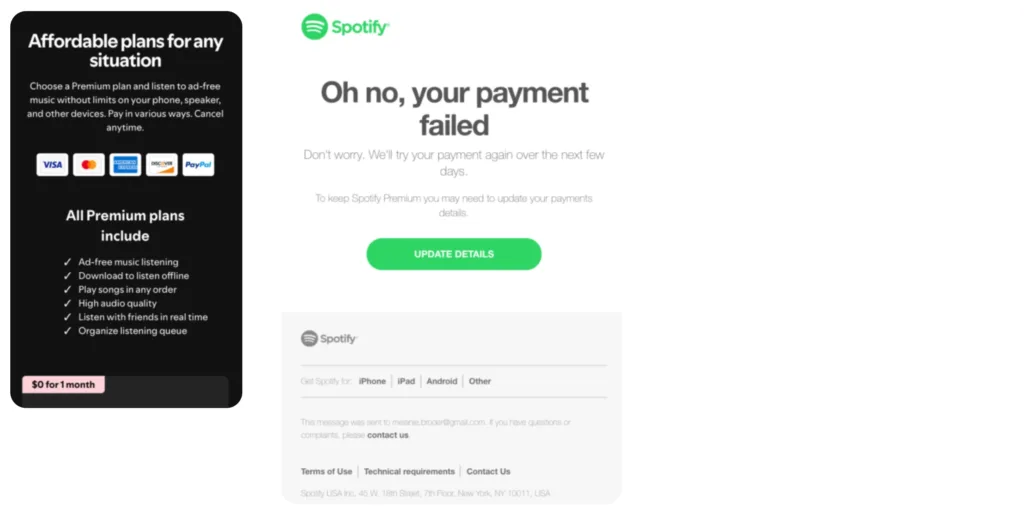
Bonus tactic: Optimize subscription pricing and packaging with proven analytical techniques
Tied to: Value Capture
Key metrics: Trial conversion rate, install-to-paid conversion rate, subscriber retention, ARPU
Pricing is one of the biggest levers in consumer subscriptions—but many apps don’t optimize it enough. Small price adjustments or better-packaged plans can significantly improve conversion rates, retention, and overall revenue—without changing the core product itself.
Here are three methods to find the right price and feature mix.
1. Van Westendorp Price Sensitivity Meter
This method identifies the acceptable price range by asking four key questions:
- At what price would this product feel too cheap to be valuable?
- At what price would it feel affordable but still high-quality?
- At what price would it feel expensive but still worth considering?
- At what price would it be too expensive to purchase?
Best for: Quick pricing insights with minimal sample size (150–200 users).
2. MaxDiff analysis
Instead of pricing, this method ranks the most vs. least important features in a subscription plan. Users repeatedly select what matters most, helping businesses understand what features drive value.
Best for: Prioritizing features that impact purchase decisions (200–300 users).
3. Conjoint analysis
This advanced technique simulates real-world purchasing decisions by asking users to choose between different subscription plans with varying prices and features. It reveals both feature importance and marginal willingness to pay.
Best for: Large-scale pricing studies (300–1000+ users) to fine-tune pricing & packaging.
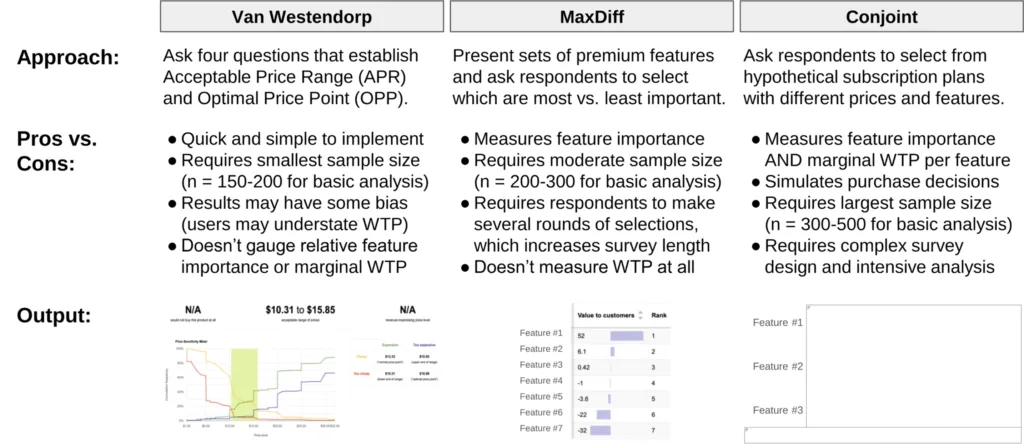
Who should you survey?
For most subscription businesses, the best audience for pricing research is existing users—both subscribers and free users. They already understand the product, which makes their feedback more reliable and easier to collect.
Surveying new users or non-customers takes extra effort because it requires paid panel services like Conjoint.ly or Qualtrics. Plus, since these users aren’t familiar with the product, the survey needs detailed explanations, which increases both cost and complexity. This approach is most useful for startups or companies launching entirely new products.
Final thoughts: The future of subscription growth with web2app
If you remember nothing else from this session, keep these four takeaways in mind:
- Consumer subscription apps are easy to launch but hard to scale. The biggest challenge? Acquiring, retaining, and monetizing users efficiently—three areas where many apps struggle.
- The best apps succeed by optimizing their Subscription Value Loop. This framework—built on value creation, value delivery, and value capture—is what separates thriving apps from those that plateau.
- The Subscription Value Loop Calculator helps quantify growth opportunities. By benchmarking performance against industry leaders, apps can pinpoint where they’re underperforming and identify the highest-impact areas for improvement.
- Proven tactics—especially web2app strategies—accelerate growth. Once you’ve identified your weak spots, targeted tactics like personalized onboarding, strategic paywall placement, optimized pricing, and alternative payment methods can significantly improve acquisition, conversion, and retention.
The most successful subscription businesses today are those that actively adapt to the post-ATT landscape and integrate web2app strategies into their growth playbooks. Whether you’re scaling an early-stage subscription app or optimizing an established one, now is the time to explore how web2app can amplify your growth. FunnelFox provides powerful tools for building, tracking, and refining high-performance web2app funnels so that you can scale smarter.
